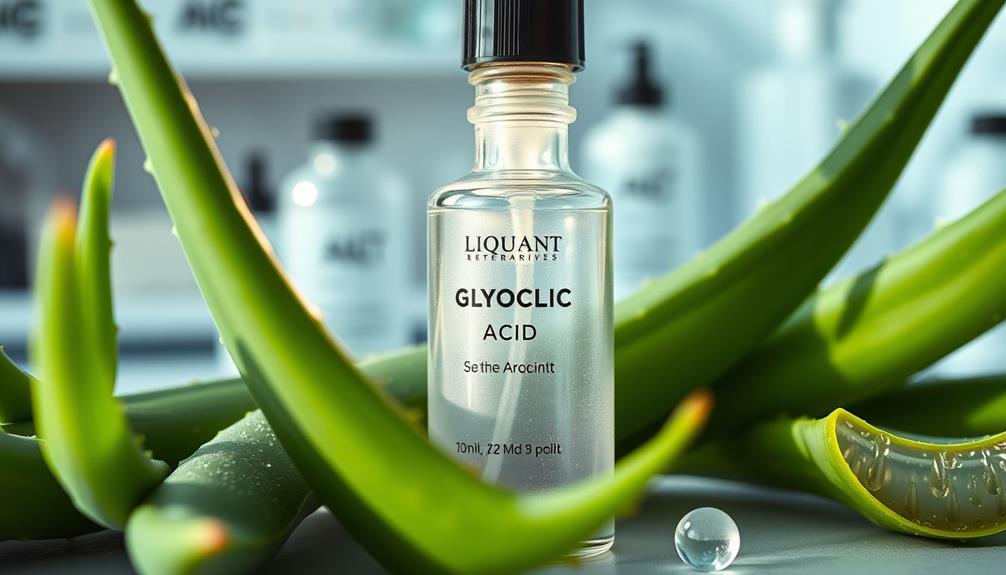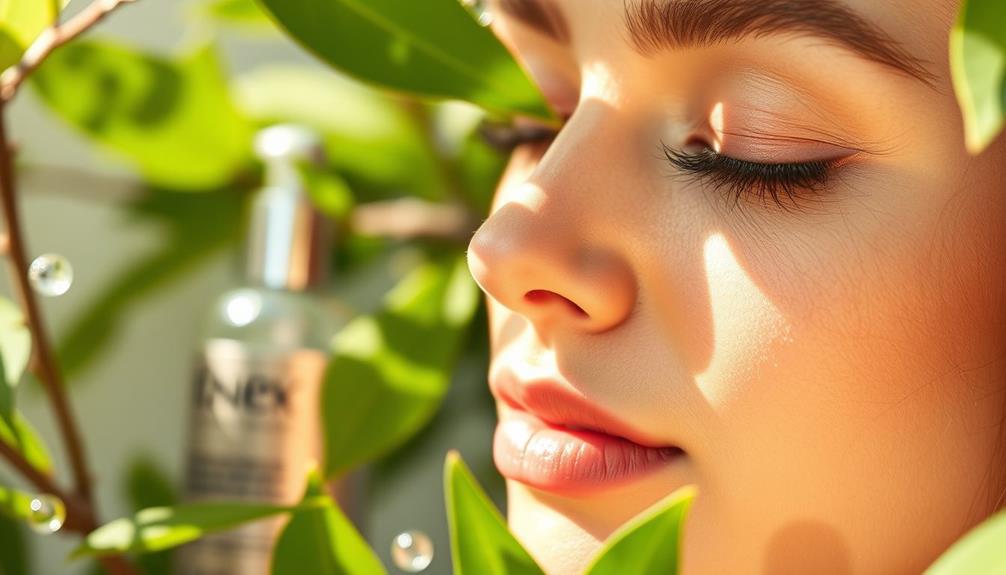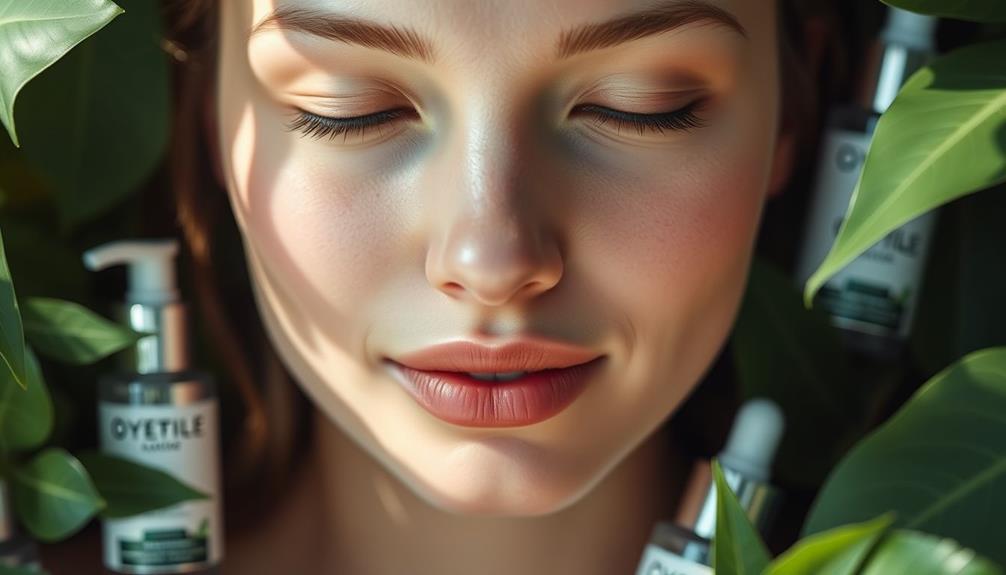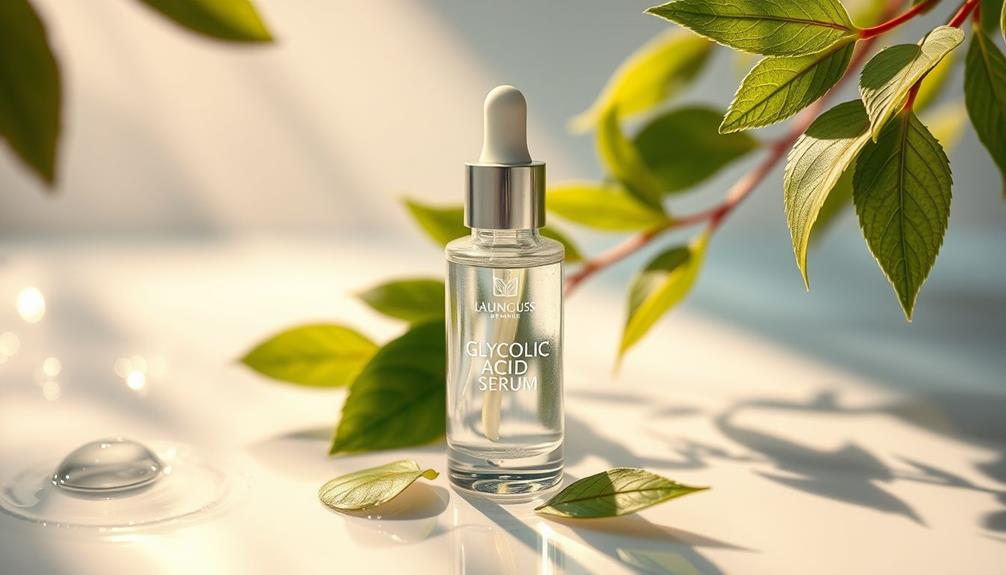Glycolic acid is a skincare powerhouse that rapidly exfoliates and rejuvenates your skin. As an alpha hydroxy acid derived from sugar cane, it dissolves dead skin cells, improving texture and promoting cell turnover. With regular use, you'll notice a more even skin tone, reduced acne, and enhanced firmness due to increased collagen production. Start with lower concentrations to build your skin's tolerance and always use sunscreen, as glycolic acid can increase sensitivity. For best results, pair it with hydrating ingredients. There's so much more to discover about maximizing its benefits for your skin!
Key Takeaways
- Glycolic acid is a potent alpha hydroxy acid derived from sugar cane, known for its exfoliating and rejuvenating properties.
- It enhances skin texture, evens skin tone, prevents acne, and stimulates collagen production for firmer skin.
- Users should start with a low concentration of 5-10% and apply it 1-2 times a week to build tolerance.
- Pairing glycolic acid with hydrating ingredients like hyaluronic acid enhances moisture, while avoiding retinoids and vitamin C minimizes irritation.
What Is Glycolic Acid?

Glycolic acid is a powerful alpha hydroxy acid (AHA) derived from sugar cane that penetrates deeply into your skin to exfoliate and rejuvenate. This acid has impressive exfoliating properties, effectively dissolving the bonds between dead skin cells. As a result, you'll notice smoother skin texture and enhanced cell turnover, which contributes to a brighter complexion.
Additionally, incorporating natural alternatives like essential oils can complement your skincare routine by promoting overall well-being and supporting skin health through their various properties, including essential oils for skin care.
Widely used in various skincare products like cleansers, toners, and serums, glycolic acid is FDA-approved for over-the-counter use. It's particularly effective for addressing skin concerns such as acne, hyperpigmentation, and signs of aging, including fine lines and wrinkles. If you're seeking a solution to improve your skin's appearance, glycolic acid could be a game changer.
While glycolic acid is generally suitable for most skin types, you should be cautious if you have sensitive skin. It's wise to start with lower concentrations to gauge your tolerance and minimize potential irritation.
Benefits for Skin

When you incorporate glycolic acid into your skincare routine, you'll experience a range of benefits that transform your complexion. This powerful ingredient works wonders by helping you exfoliate the skin, effectively removing dead skin cells and promoting a radiant complexion. Additionally, you can enhance your skincare experience by integrating essential oils for specific conditions, which can complement the benefits of glycolic acid.
Here are some key Glycolic Acid benefits you can expect:
- Improved Skin Texture: Regular use can greatly enhance your skin's texture, making it smoother and more refined.
- Even Skin Tone: Glycolic acid helps fade dark spots and hyperpigmentation, allowing your skin tone to even out over time.
- Prevent Acne Breakouts: By unclogging pores, it helps prevent acne breakouts, giving you clearer skin.
Additionally, glycolic acid stimulates collagen production, which means you'll notice improved skin firmness and a reduction in fine lines and wrinkles.
You might see initial improvements in your skin within just a week, while more considerable results for issues like acne and dark spots typically develop within 2 to 6 weeks.
Embracing glycolic acid in your regimen is a powerful step towards achieving healthier, more vibrant skin.
How to Use Glycolic Acid

To get the best results from glycolic acid, start with a low concentration of 5-10% and gradually increase usage as your skin adjusts.
Incorporating a consistent skincare routine, much like maintaining a consistent sleep schedule for better rest, can enhance the effectiveness of glycolic acid.
Begin by applying glycolic acid to clean, dry skin using a cotton pad or your fingertips. Remember to avoid sensitive areas like your eyes and lips.
Use it 1-2 times a week initially, adjusting the frequency of use based on how your skin responds.
Always perform a patch test on a small area of skin before full application to check for any irritation. If your skin tolerates the glycolic acid well, you can increase the concentration and frequency, but do so slowly.
It's best to use glycolic acid in the evening to reduce sun sensitivity, allowing for ideal absorption after cleansing.
After application, follow up with a moisturizer to help combat dryness.
Lastly, don't forget to apply a broad-spectrum sunscreen with an SPF of 30 or higher daily, as glycolic acid can make your skin more susceptible to sun damage.
This routine will help you effectively exfoliate and enhance your skin's texture while ensuring its protection.
Side Effects and Precautions

Using glycolic acid can lead to side effects like redness, burning, and peeling, especially for those new to it or using higher concentrations. To minimize these side effects, consider the following precautions:
- Start with lower concentrations: If you have sensitive skin, begin with a glycolic acid concentration of 5-10%. This helps your skin gradually build tolerance without overwhelming it.
- Limit frequency: Use glycolic acid 1-2 times a week at first. As your skin adjusts, you can increase the frequency, but always pay attention to how your skin reacts.
- Prioritize sun protection: Glycolic acid can increase skin sensitivity to the sun, making daily broad-spectrum sunscreen (SPF 30+) essential. This prevents sunburn and further irritation.
Ingredient Compatibility
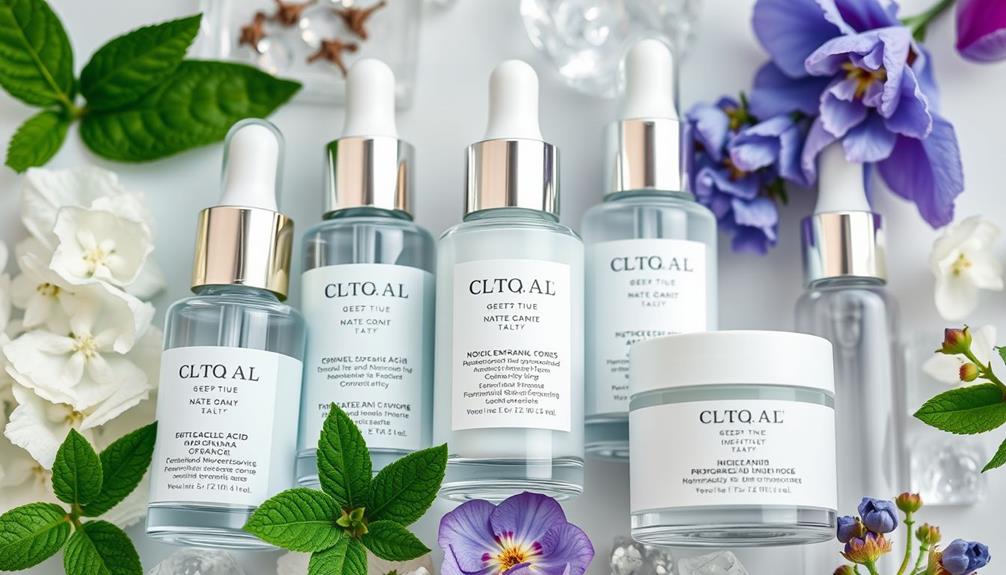
When using glycolic acid, you'll want to pair it with hydrating ingredients like hyaluronic acid and niacinamide for the best results.
However, it's essential to steer clear of combining it with retinoids or benzoyl peroxide, as this can irritate your skin.
Being mindful of these combinations will help you achieve a more effective skincare routine without discomfort.
Safe Ingredient Pairings
Glycolic acid pairs well with hydrating ingredients like hyaluronic acid and niacinamide, enhancing moisture without causing irritation. This combination not only promotes cell exfoliation but also guarantees your skin remains hydrated and healthy.
Here are three safe ingredient pairings for peak results:
- Hyaluronic Acid: This powerful humectant attracts moisture, making it perfect to pair with glycolic acid. Together, they keep your skin plump and hydrated.
- Niacinamide: Known for its soothing properties, niacinamide works well with glycolic acid to minimize skin irritation and enhance your skin's barrier function.
- Peptides: These amino acid chains support skin repair and can amplify the anti-aging effects when used alongside glycolic acid.
While pairing ingredients, remember to use vitamin C separately to avoid irritation, ideally in the morning, and reserve glycolic acid for your evening routine.
Also, don't skip broad-spectrum sunscreen (SPF 30+) during the day to protect your skin from increased sun sensitivity.
Ingredients to Avoid
Certain ingredients should be avoided alongside glycolic acid to prevent irritation and guarantee your skincare routine remains effective.
Mixing glycolic acid with retinoids, such as retinol or tretinoin, can heighten sensitivity and lead to discomfort. Similarly, combining glycolic acid with salicylic acid or benzoyl peroxide may exacerbate dryness and irritation, making your skin more reactive.
You should also steer clear of using physical exfoliants, like scrubs, with glycolic acid. This combination can result in over-exfoliation, which risks damaging your skin barrier.
Additionally, pairing glycolic acid with vitamin C in the same application may cause irritation; it's best to use vitamin C in the morning and glycolic acid at night to avoid conflict.
Lastly, avoid using hydroquinone with glycolic acid to minimize the risk of skin irritation and enhance the effectiveness of each ingredient.
Skin Type Suitability

Understanding your skin type is essential for safely incorporating glycolic acid into your skincare routine. This powerful ingredient can work wonders, but its effectiveness varies by skin type. Here's a quick guide to help you determine if glycolic acid is right for you:
- Oily and Acne-Prone Skin: Glycolic acid's exfoliating properties make it a fantastic choice for you. It helps unclog pores and reduce breakouts by controlling excess sebum production.
- Combination Skin: You can also benefit from glycolic acid, as it balances oiliness while providing gentle exfoliation. Just be mindful of how your skin reacts.
- Dry and Sensitive Skin: If you fall into this category, start with lower concentrations (5-10%) to minimize irritation. You might need to use it infrequently and verify you're incorporating adequate hydration to combat dryness.
If you have a sensitive skin condition, like rosacea, consulting a dermatologist before using glycolic acid is a wise move.
Application Tips
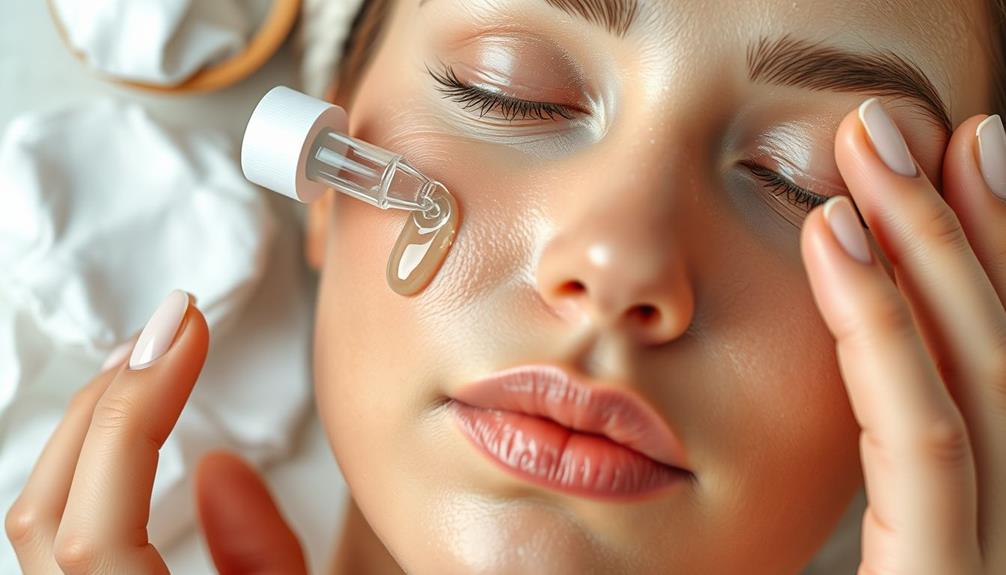
To effectively incorporate glycolic acid into your routine, start with a low concentration of 5-10% and use it 1-2 times a week. This gradual approach helps build your skin tolerance and minimizes irritation.
Always conduct a patch test on a small area of skin before full application, especially if you have sensitive skin.
When applying glycolic acid, make sure your skin is clean and dry. Use a cotton pad or your fingertips, but avoid sensitive areas like the eyes and lips.
For ideal results, apply glycolic acid in the evening after cleansing. This timing allows for better absorption and effectiveness.
Follow up with a moisturizer to counteract potential dryness and soothe your skin after exfoliation.
Research and Studies

Numerous studies highlight the impressive benefits of glycolic acid in skincare, showcasing its ability to enhance collagen production and improve skin texture. By incorporating glycolic acid into your routine, you can expect to see significant improvements in various skin concerns.
Here are three key benefits backed by research:
- Collagen Production: Studies demonstrate that glycolic acid boosts collagen production, resulting in improved skin elasticity and a noticeable reduction in fine lines and wrinkles.
- Acne Treatment: Research shows that glycolic acid effectively reduces acne lesions by promoting exfoliation and unclogging pores, making it a trusted option for acne vulgaris.
- Hyperpigmentation and Photodamage: Clinical trials reveal that glycolic acid treats hyperpigmentation, leading to a more even skin tone. It also inhibits UVB-induced skin damage, offering protective benefits against photodamage.
Additionally, glycolic acid is a popular choice in chemical peels, where it enhances overall skin texture and radiance across diverse skin types.
With consistent use, the benefits of glycolic acid can transform your complexion, making it a powerful ally in your skincare arsenal. When used regularly, glycolic acid can help to exfoliate the skin, improve texture, and reduce the appearance of fine lines and wrinkles. This potent ingredient can also help to fade dark spots, brighten the skin, and promote a more even skin tone. Incorporating glycolic acid in skincare can help to rejuvenate and revitalize your complexion, leaving you with a more radiant and youthful appearance.
Frequently Asked Questions
What Do Dermatologists Say About Glycolic Acid?
Dermatologists say glycolic acid's effective for improving skin texture and reducing fine lines. They recommend starting with lower concentrations, using sun protection, and combining it with hydrating agents to minimize irritation while enhancing results.
What Is the Science Behind Glycolic Acid Peel?
Glycolic acid peels work wonders for your skin! They penetrate deeply, breaking down dead skin bonds, enhancing exfoliation, and promoting collagen production. You'll see noticeable improvements in texture and tone after just a few treatments.
What Does Glycolic Acid Do to the Skin?
Glycolic acid exfoliates your skin, breaking down dead cells and promoting cell turnover. It boosts collagen production, reduces fine lines, evens skin tone, unclogs pores, and helps with acne, revealing a smoother, brighter complexion.
What Is the Chemistry Behind Glycolic Acid?
Glycolic acid's chemistry involves its small molecular structure, allowing deeper skin penetration. It breaks down dead skin cell bonds through chemical exfoliation, promoting cell turnover and enhancing collagen production for healthier, more youthful skin.
Conclusion
In the world of skincare, glycolic acid is like a secret weapon, gently revealing your skin's true potential.
By incorporating it into your routine, you'll embrace smoother, more radiant skin that's ready to shine.
Just remember to tread lightly, as every powerful ally comes with a few caveats.
With the right approach, you'll release a luminous glow that speaks volumes.
So go ahead, let glycolic acid work its magic and transform your skincare journey!
